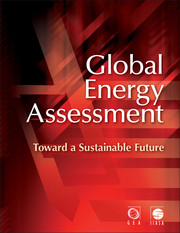Book contents
- Frontmatter
- Contents
- Section 1
- Section 2
- Section 3
- Cluster 1
- Cluster 2
- Cluster 3
- Cluster 4
- Chapter 22 Policies for Energy System Transformations: Objectives and Instruments
- Chapter 23 Policies for Energy Access
- Chapter 24 Policies for the Energy Technology Innovation System (ETIS)
- Chapter 25 Policies for Capacity Development
- Section 4
- Index
- References
Chapter 24 - Policies for the Energy Technology Innovation System (ETIS)
Published online by Cambridge University Press: 05 September 2012
- Frontmatter
- Contents
- Section 1
- Section 2
- Section 3
- Cluster 1
- Cluster 2
- Cluster 3
- Cluster 4
- Chapter 22 Policies for Energy System Transformations: Objectives and Instruments
- Chapter 23 Policies for Energy Access
- Chapter 24 Policies for the Energy Technology Innovation System (ETIS)
- Chapter 25 Policies for Capacity Development
- Section 4
- Index
- References
Summary
Executive Summary
Innovation and technological change are integral to the energy system transformations described in the Global Energy Assessment (GEA) pathways. Energy technology innovations range from incremental improvements to radical breakthroughs and from technologies and infrastructure to social institutions and individual behaviors. This Executive Summary synthesizes the main policy-relevant findings of Chapter 24. Specific positive policy examples or key takehome messages are highlighted in italics.
The innovation process involves many stages – from research through to incubation, demonstration, (niche) market creation, and ultimately, widespread diffusion. Feedbacks between these stages influence progress and likely success, yet innovation outcomes are unavoidably uncertain. Innovations do not happen in isolation; interdependence and complexity are the rule under an increasingly globalized innovation system. Any emphasis on particular technologies or parts of the energy system, or technology policy that emphasizes only particular innovation stages or processes (e.g., an exclusive focus on energy supply from renewables, or an exclusive focus on Research and Development [R&D], or feed-in tariffs) is inadequate given the magnitude and multitude of challenges represented by the GEA objectives.
A first, even if incomplete, assessment of the entire global resource mobilization (investments) in both energy supply and demand-side technologies and across different innovation stages suggests current annual Research, Development & Demonstration (RD&D) investments of some US$50 billion, market formation investments (which rely on directed public policy support) of some US$150 billion, and an estimated US$1 trillion to US$5 trillion investments in mature energy supply and end-use technologies (technology diffusion).
- Type
- Chapter
- Information
- Global Energy AssessmentToward a Sustainable Future, pp. 1665 - 1744Publisher: Cambridge University PressPrint publication year: 2012
References
- 22
- Cited by



